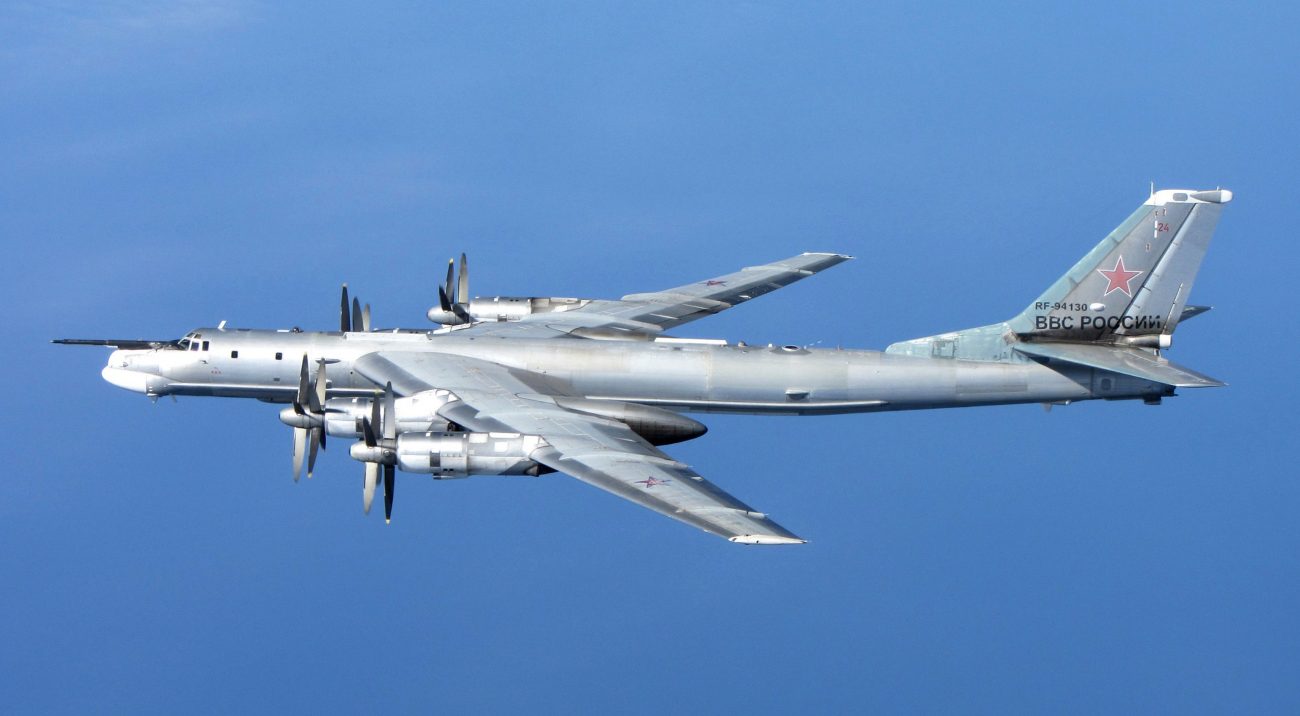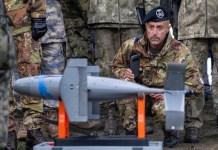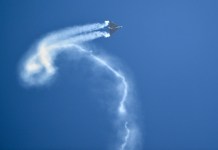For the first time, Russian and Chinese bombers ‘flexed muscles’ near the US on July 24. This unusual event involved bombers from both nations approaching US territory at the same time, underscoring the growing partnership between Russia and China.
NORAD (North American Aerospace Defense Command) reported that two Russian TU-95 Bears and two Chinese H-6 strategic bombers entered the Alaska Air Defense Identification Zone (ADIZ), an area of international airspace near North America. The bombers were accompanied by Russian Su-35S and Su-30SM fighters.
This incident marked the first time Russian and Chinese military aircraft jointly entered the Alaska ADIZ. It was also the debut appearance of Chinese H-6 bombers in the region.
According to a US defense official, the intercept operation involved American F-16s and F-35s alongside Canadian CF-18s and support aircraft.
NORAD said, “The Russian and PRC aircraft remained in international airspace and did not enter American or Canadian sovereign airspace.”
Russian MoD publishes footage of joint patrols by aircraft of the Russian Aerospace Forces and the Chinese Air Force off the coast of Alaska.
The flight duration of a group of aircraft consisting of two Tu-95MS strategic bombers and a pair of H-6Ks was more than 5 hours.
Cover… https://t.co/1IazEFGPYs pic.twitter.com/QTW9uSCHKI
— Clash Report (@clashreport) July 25, 2024
It added, “This Russian and PRC activity in the Alaska ADIZ is not seen as a threat, and NORAD will continue to monitor competitor activity near North America and meet presence with presence.”
Despite the F-35 and F-16 being excellent warplanes, they are not known for their interception prowess. Experts say the F-22 and F-15 are the US’s top air superiority fighters, and they can challenge a powerful bomber pack escorted by mighty Su-35 fighters.
The Alaska ADIZ, extending 150 miles from the U.S. coastline, serves as a buffer zone where the US requires aircraft to identify themselves.
While it is not uncommon for Russian bombers to be intercepted in this zone, as evidenced by incidents in February and March, the joint Russian-Chinese flight on July 24 was unprecedented. It highlighted the growing military partnership between Beijing and Moscow.
Earlier this week, US Deputy Secretary of Defense, Kathleen Hicks, noted China’s expanding military interest in the Arctic and its cooperation with Russia as the Pentagon presented its latest Arctic Strategy.

“Melting Arctic ice caps are opening new shipping lanes and attracting increased interest and activity from both the People’s Republic of China and Russia,” said Hicks.
She further emphasized the growing collaboration between China and Russia in the Arctic, both commercially and militarily.
She added, “More troubling, we’ve seen growing cooperation between the PRC and Russia in the Arctic, commercially with the PRC being a major funder of Russian energy exploitation in the Arctic and increasingly militarily with Russia and China conducting joint exercises off the coast of Alaska.”
Russia, China Intensify Military Cooperation
Russia and China have increasingly aligned against the United States and its allies since Russia’s 2022 invasion of Ukraine. Therefore, the presence of Chinese aircraft in the US Air Defense Identification Zone (ADIZ) was not unexpected.
Joint military maneuvers involving Russian and Chinese forces have become more frequent. In August 2023, Russia and China carried out a notable naval flotilla near Alaska, monitored closely by US Navy vessels.
Before this, in November 2022, Russian Tu-95MS and Chinese H-6K bombers conducted “joint patrols” over the Sea of Japan and the East China Sea, with aircraft from both nations landing on each other’s airfields. That exercise marked the first instance of extensive cooperation between the two countries.
In March this year, Air Force Gen. Gregory M. Guillot, the head of NORAD, predicted that Chinese air operations in the US ADIZ would likely occur “as early as this year.” Chinese aircraft entering the US ADIZ represents an expansion of the People’s Liberation Army’s (PLA) reach.
The bombers involved in these joint exercises are crucial to the military strategies of both nations. The Russian Tu-95MS is well-known as a key nuclear-capable asset within Russia’s Long-Range Aviation.
The specifics of China’s H-6K nuclear capability are somewhat ambiguous; however, a prior Pentagon report on the Chinese military referred to the similar H-6N variant as Beijing’s “first nuclear-capable air-to-air refuelable bomber.”
In addition to aerial operations, Russian and Chinese ground troops have also increased their collaboration. In 2021, the PLA and the Russian Army participated in the ZAPAD/INTERACTION drills, with the latter portion conducted on Chinese soil for the first time.

These exercises included theoretical and systems training, weapon swaps, and a culminating exercise to enhance understanding and cooperation between the two militaries.
Over the years, the PLA has frequently entered Taiwan’s ADIZ, at times sending dozens of planes in a single day. Defense experts suggest these maneuvers may be probing Taiwanese defenses or attempting to lull them into complacency.
This growing military cooperation between Russia and China reflects their shared strategic interests and an increasingly united front against US influence.
Fausto Chou, a Taiwanese Journalist and the executive editor of Taiwanese digital media outlet Eat News, told EurAsian Times, “China and Russia’s weapons systems share the same specifications, tracing back to the Soviet era when the Soviet Communist Party assisted the Chinese Communist Party. This historical connection explains why these two countries can conduct joint military exercises.”
He pointed out, “Another reason, of course, is that they share common interests and have formed a new Axis to counter the Western alliance led by the United States and the United Kingdom.”
“Additionally, something I believe you should pay attention to is that over 60 Chinese defense companies participated in this year’s Eurosatory in Paris, showcasing weapons manufactured to NATO specifications. This is a warning sign for NATO,” he added.
He further explained, “These [joint] exercises ensure that bilateral communication, strategies, and abbreviations are standardized and mutually understandable. This is similar to the joint military exercises conducted by the United States with Japan and South Korea. The more comprehensive the communication, the better they can support each other in the event of a war.”
Defense experts believe that the joint drills and patrols between China and Russia bring significant practical advantages, particularly for China’s People’s Liberation Army (PLA). The PLA, which has not engaged in combat since 1979, stands to gain invaluable insights and experience from Russia’s extensive recent combat operations.
These joint exercises provide the PLA with an opportunity to observe and learn modern warfare tactics, operational strategies, and battlefield management from a military that has been actively engaged in conflicts over the past few years.
On the other hand, by partnering with China, Moscow not only gains a powerful ally but also strengthens its claims of military prowess and global influence.
Speaking to the EurAsian Times, Shashank S. Patel, a Geopolitical and Defense Analyst, said, “Although it’s a fact that the Russian and Chinese aerial patrol over the waters of Chukchi and Bering Sea is totally within the relevant airspace, it is at the same time a joint message for NATO to tame their over-enthusiasm over the North Pacific and Arctic affairs.”
Patel highlighted, “After several maritime provocations by US-led NATO forces, it was obvious for Russian forces to respond timely within international laws. What amazed me was the Chinese joint efforts in the ADIZ area.”
He explained, “Choosing the Alsaka region for joint exercises pointed out that China wants to establish its self-proclaimed narrative of an Arctic state. It will provide another juncture for them to provoke allies in the surrounding area under gunboat diplomacy.”
“The current flight was not a threat to any state in the region but parallelly showed the capabilities of military engagement plans of Russia and China. Earlier, similar efforts by these countries in the East signaled prudence of joint strategic alignments shaped under American pressure tactics,” Patel added.
He concluded that the frequent alignment of NATO assets over the past two years has indirectly compelled China and Russia to cooperate. While this particular bomber’s flights over Alaska may not currently pose a threat to the USA or its allies, this does not preclude the possibility of future escalation.
- Contact the author at ashishmichel(at)gmail.com
- Follow EurAsian Times on Google News




